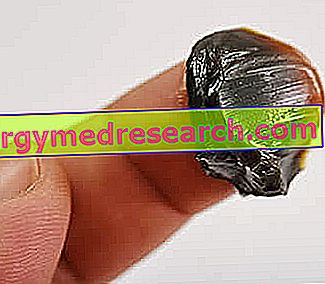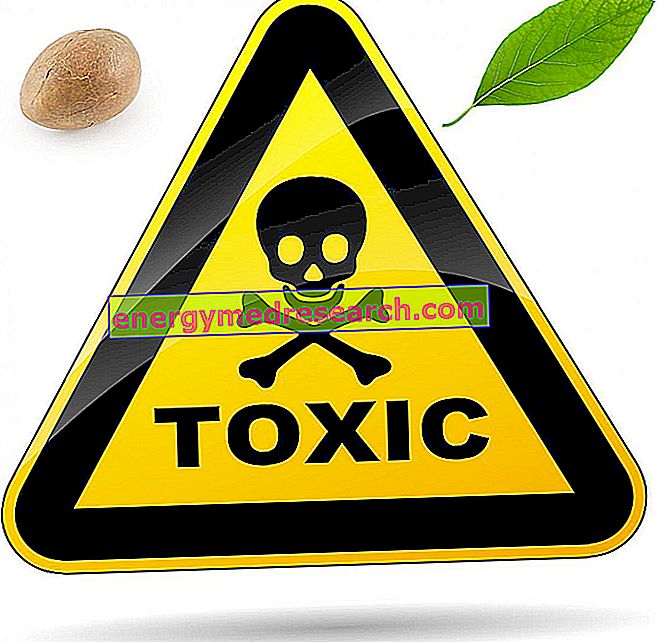What is Vaseline?
Among paraffinic hydrocarbons, Vaseline (also known as "petrolatum") certainly plays a fundamental role: obtained from the residues of petroleum distillation, Vaseline represents a particularly exploited petrolatum in the cosmetic sphere as an excipient of ointments, creams and ointments.

Vaseline owes its name to R. Chesebrough, who, towards the 1860s, was able to produce some samples of paraffinic derivatives. The term Vaseline is composed of two German words: wasser (water) and elaion (oil).
Features
Features and chemical analysis of Vaseline
Vaseline is a heterogeneous mixture of heavy oils (25 carbon atoms) and saturated paraffinic hydrocarbons, both solid and liquid, obtained from petroleum residues.
The consistency of vaseline is soft, waxy to the touch and unctuous; the structure appears to be amorphous and homogeneous. In general, Vaseline is odorless and colorless; sometimes it is translucent-semitransparent yellow.
Vaseline melts at 37 ° C and the boiling point reaches 302 ° C. The hydrocarbon compound does not oxidize on contact with air and is chemically inert, which is why it is highly appreciated in the cosmetic and pharmaceutical fields.
Being a derivative of petroleum, it is easily understandable that vaseline is insoluble in water and soluble, instead, in solvents such as benzene, chloroform and aromatic hydrocarbons in general.
Production
Production stages of Vaseline
From the distillation of the oils some lubricating fractions are obtained, subsequently subjected to refining. First, the fractions obtained are carefully processed with sulfuric acid, then neutralized with soda and washed. In the last step of the refining, these are bleached with special bleaching coals and, finally, filtered.
Types of Vaseline
There is no single type of Vaseline; white petrolatum (or white vaseline) is of superior quality, followed by yellow and brown petrolatum, qualitatively less important products because they contain carcinogenic waste substances, derive from the refining process.
- White Vaseline : remarkably refined and quality aliphatic hydrocarbon, widely used as an emollient and lubricant. It is not carcinogenic.
- Yellow Vaseline : it is more oily than white vaseline, and potentially more dangerous. Yellow Vaseline counts more carcinogenic impurities; however, this is also sometimes used in cosmetics (in smaller quantities). The yellow vaseline is more oily than the white one.
- Brown Vaseline : more polluted by residues from the oil refining process. It is not used in the pharmaceutical or cosmetic fields.

uses
As mentioned, Vaseline is widely used in the cosmetic and pharmaceutical industry, but not only, since there are many other domestic uses of this substance.
The main uses of this substance will be briefly described below.
Medical-pharmaceutical uses
In the pharmaceutical field, Vaseline is widely used as an excipient with an emollient and lubricating action for the preparation of creams, ointments and ointments. A typical example of the use of vaseline in the pharmaceutical field is given by the galenic preparation of salicylic acid based ointments (salicylic vaseline) with keratolytic and antifungal action. Given the keratolytic action of salicylic vaseline, this galenic preparation (at appropriate concentrations) is widely used in psoriasis patients (subject to medical prescription).
In addition to being used as an excipient, Vaseline is also used as an emollient laxative, often together with vegetable oils having similar properties (almond oil, olive oil) or as a base in which to disperse mild laxatives (mass-forming osmotic agents such as magnesia ); in fact, due to its lubricating properties, vaseline taken orally facilitates the transit of intestinal contents. If used alone, on an empty stomach, the suggested average intake is 15-60 ml per day, sufficient to produce a consistent laxative effect within 6-10 hours of intake.
Furthermore, Vaseline can be used in medicinal oils enriched with zinc, carbolic acid or other active ingredients.
Cosmetic uses
Given its emollient properties, Vaseline is also widely used in cosmetics (INCI nomenclature: Petrolatum), where it is used in the formulation of a wide variety of products, such as:

- Gels, conditioners and sticks for dry and dehydrated lips;
- Lip gloss and lipsticks;
- Body hygiene products;
- Shaving products;
- Massage oils;
- Body creams;
- Hair conditioners.
Spread on the skin, Vaseline creates a sort of protective film (occlusive film), able to decrease trans-epidermal water loss. The occlusive film that is thus created is also able to protect (albeit in a limited way) the skin from the aggression of potentially irritating external agents.
Did you know that ...
At one time, Vaseline was also used as a lubricant for condoms: currently, the use of Vaseline for this purpose has gone out of use, since it reacts with the latex of the condom, deteriorating it.
Other uses
The uses of Vaseline - especially in the vast world of DIY - there are really many, some of which could be called somewhat questionable.
However, among the alternative uses of Vaseline we recall the one that provides for its application on the teeth in order to obtain a particular glossy effect.
Another rather curious use of Vaseline foresees the application near the nostrils in order to avoid allergic attacks in individuals with pollen allergy (when it comes to allergies, it is still necessary the opinion of the doctor before carrying out any DIY treatment ).
We also remind you that Vaseline can be used at the end of a tattoo directly on the affected area, both because of its emollient properties and because of its ability to create a protective film on the same tattoo. The formation of the occlusive film is very useful to protect the skin (already irritated and inflamed) from external insults. In fact, nowadays the use of Vaseline in this area is becoming increasingly disused and a growing number of tattoo artists prefer to advise their customers on the application of other products, such as, for example, the soothing pastes that are used for the diaper change (eg Bepanthenol®). These pastes - besides exerting a protective action on the skin - have soothing, moisturizing, firming and regenerating properties.
Finally, Vaseline can also be used for the production of industrial lubricants, shoe creams, anti-rust products, etc.
Side effects
Although, in principle, Vaseline is a product well tolerated by most individuals, its use is certainly not free from undesirable effects. These effects naturally differ according to the use made of the substance (external or internal).
When taken orally as a laxative, Vaseline may cause the following side effects:
- Delayed healing of anal wounds;
- Possibility of absorption and deposition in the lymph nodes, mucosa, liver and spleen, resulting in foreign body reactions.
Abuse of this practice can also cause anal leakage of vaseline, resulting in local itching up to pictures of anal stenosis.
When used topically (pure, or inside cosmetic products or pharmaceutical preparations), Vaseline can cause allergic reactions in sensitive individuals.
Moreover, since Vaseline creates an occlusive film when spread on the skin, it could exert a comedogenic action in predisposed individuals.
Risks and Dangers
As discussed above, Vaseline is a derivative of petroleum: in this regard it is potentially carcinogenic. So much so that some scientific studies have shown a possible correlation between the use of vaseline and the formation of liver neoplasms. [taken from //it.wikipedia.org/]
However, at present, white vaseline is still considered a safe product and for this reason it can be used in the preparation of drugs, as well as in the most disparate cosmetic formulations.
Summary
Vaseline: in short
Vaseline | Paraffinic hydrocarbon obtained from the residues of petroleum distillation: it is the quintessential oil gel, used to indicate the entire category of petrolatum. |
Etymology of the term | Vaseline owes its name to R. Chesebrough: the term is composed of two German words: wasser (water) and elaion (oil). |
Chemical analysis of Vaseline |
|
Extraction process | Vaseline is derived from petroleum residues: Oil distillation → obtaining lubricating fractions → refining:
|
Vaseline classification | Vaseline is classified as white, yellow, brown, depending on the color and potentially carcinogenic contained impurities. |
Vaseline: uses | Wide use in the cosmetic and pharmaceutical industry:
|
Side effects |
|
Vaseline: dangers | Potentially carcinogenic Possible correlation between the use of vaseline and the formation of liver neoplasms. |




